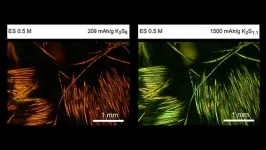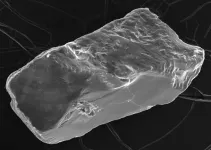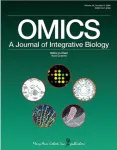(Press-News.org) FOR IMMEDIATE RELEASE
Monday, September 16, 2024
Contact:
Jillian McKoy, jpmckoy@bu.edu
Michael Saunders, msaunder@bu.edu
##
Lower Neighborhood Opportunity May Increase Risk for Preterm Birth
A new study suggests that neighborhoods with fewer educational, health, environmental, and socioeconomic resources may increase one’s risk for preterm birth and contribute to the racial gap in preterm birth in the Commonwealth.
Preterm birth, defined as a live birth before 37 weeks of pregnancy, is the second-leading cause of infant mortality in the United States, and one that disproportionately affects Black and Hispanic birthing people. While individual-level factors such as poverty, age, and health status may contribute to racial/ethnic disparities in preterm birth, researchers believe there are broader structural challenges that may be driving the racial gap in this all-too-common birth complication.
A new study led by Boston University School of Public Health (BUSPH) examined preterm births in Massachusetts, where 1 in 11 live births are premature, and found that the social characteristics of a birthing parent’s neighborhood is associated with their risk of experiencing an early delivery.
Published in JAMA Network Open, the study found that more than half of Black and Hispanic infants were born into very low-opportunity neighborhoods, and that babies born into these neighborhoods had a 16-percent greater risk of being born preterm. Researchers assessed neighborhood opportunity level based on a variety of educational, health, environmental, and socioeconomic characteristics identified in the Childhood Opportunity Index (COI), a widely used composite measure that currently includes 44 indicators by census tract.
The study sheds new light on the health consequences of structural racism and historically discriminatory practices—such as redlining and disproportionate exposures to pollutants—that continue to shape modern-day neighborhood conditions and circumstances. Because neighborhood social opportunity is inequitably distributed by race and ethnicity, the COI serves as a valuable measure of both historic and ongoing structural racism, the researchers say.
“Our findings suggest that the context of social opportunity has an impact on children’s health before they are even born, and may in part be a driver of persistent racial and ethnic inequities in preterm birth,” says study lead and corresponding author Dr. Candice Belanoff, clinical associate professor of community health sciences at BUSPH. “The effect remained after we controlled for factors such as maternal/birthing parent health and individual social position.”
Dr. Belanoff and colleagues from BUSPH, Simmons SSW, the University of Illinois, Chicago (UIC), and Brandeis University (Brandeis) utilized Massachusetts birth certificate data by census tract for more than 260,000 singleton infants born in the Boston, Springfield, and Worcester metropolitan areas from February 2011 to December 2015, to explore possible links between neighborhood opportunity levels and preterm births.
Preterm birth was highest among Black infants at 8.4 percent, followed by Hispanic infants at 7.3 percent, Asian or Pacific Islander infants at 5.8 percent, and White infants at 5.8 percent. Compared to White and Asian or Pacific Islander infants, Black and Hispanic infants were approximately 54 percent more likely to be born into very low child opportunity neighborhoods, compared to White infants (11.8 percent) and Asian or Pacific Islander infants (19.6 percent) Similarly, Black and Hispanic infants were also least likely to be born into very high child opportunity neighborhoods, at 6 percent and 6.7 percent, respectively.
“While many lower opportunity neighborhoods are rich cultural hubs and locations of incredible community activism and power, they still suffer the effects of economic exclusion, they are still closer to toxic environmental exposures, and they still generally feature fewer of the resources that help people flourish across the life course,” Dr. Belanoff says.
“This is why it is important to look beyond the individual if we are ever going to reduce or eliminate the racial/ethnic gap in birth outcomes,” says study senior author Dr. Joanna Almeida, professor and Eva Whiting White Endowed Chair at Simmons SSW. “We need to address the inequitable distribution of resources and access to neighborhood opportunity in order to move the needle on racial and ethnic inequities in preterm birth.”
The study was coauthored by Adriana Black, director of health affairs diversity, equity & inclusion and doctoral student at UIC; Dr. Collette Ncube, assistant professor of epidemiology at BUSPH; and Dr. Dolores Acevedo-Garcia, Samuel F. and Rose B. Gingold Professor of Human Development and Social Policy at Brandeis and project director of diversitydatakids.org, the research program that manages the COI.
**
About Boston University School of Public Health
Founded in 1976, Boston University School of Public Health is one of the top ten ranked schools of public health in the world. It offers master's- and doctoral-level education in public health. The faculty in six departments conduct policy-changing public health research around the world, with the mission of improving the health of populations—especially the disadvantaged, underserved, and vulnerable—locally and globally.
END
Lower neighborhood opportunity may increase risk for preterm birth
A new study suggests that neighborhoods with fewer educational, health, environmental, and socioeconomic resources may increase one’s risk for preterm birth and contribute to the racial gap in preterm birth in the Commonwealth.
2024-09-16
ELSE PRESS RELEASES FROM THIS DATE:
Analysis finds cardiac devices recalled for safety reasons infrequently subjected to premarket or postmarket testing
2024-09-16
Embargoed for release until 5:00 p.m. ET on Monday 16 September 2024
@Annalsofim
Below please find summaries of new articles that will be published in the next issue of Annals of Internal Medicine. The summaries are not intended to substitute for the full articles as a source of information. This information is under strict embargo and by taking it into possession, media representatives are committing to the terms of the embargo not only on their own behalf, but also on behalf of the organization they represent.
----------------------------
1. ...
Trailblazers in plasma turbulence computer simulations win 2024 James Clerk Maxwell Prize
2024-09-16
A pair of physicists with long ties to PPPL are being honored for their foundational work on turbulence in plasma. Understanding why instabilities occur and how to limit them is critical to perfecting fusion as a stable energy source for the electrical grid.
Greg Hammett, a PPPL theoretical and computational principal research physicist, and Bill Dorland, former associate laboratory director for computational sciences and current Lab adviser, have won the 2024 James Clerk Maxwell Prize for Plasma Physics. The American ...
Technology could boost renewable energy storage
2024-09-16
Renewable energy sources like wind and solar are critical to sustaining our planet, but they come with a big challenge: they don't always generate power when it's needed. To make the most of them, we need efficient and affordable ways to store the energy they produce, so we have power even when the wind isn't blowing or the sun isn't shining.
Columbia Engineering material scientists have been focused on developing new kinds of batteries to transform how we store renewable energy. In a new study published September 5 by Nature Communications, the team used K-Na/S batteries that combine inexpensive, readily-found elements -- ...
Introducing SandAI: A tool for scanning sand grains that opens windows into recent time and the deep past
2024-09-16
Stanford researchers have developed an artificial intelligence-based tool – dubbed SandAI – that can reveal the history of quartz sand grains going back hundreds of millions of years. With SandAI, researchers can tell with high accuracy if wind, rivers, waves, or glacial movements shaped and deposited motes of sand.
The tool gives researchers a unique window into the past for geological and archeological studies, especially for eras and environments where few other clues, such as fossils, are preserved ...
Critical crops’ alternative way to succeed in heat and drought
2024-09-16
Scientists have discovered that certain plants can survive stressful, dry conditions by controlling water loss through their leaves without relying on their usual mechanism - tiny pores known as ‘stomata’.
Nonstomatal control of transpiration in maize, sorghum, and proso millet – all C4 crops which are critical for global food security – gives these plants an advantage in maintaining a beneficial microclimate for photosynthesis within their leaves.
This allows the plants to absorb carbon dioxide ...
Students with multiple marginalized identities face barriers to sports participation
2024-09-16
MINNEAPOLIS/ST. PAUL (09/16/2024) — The U.S. Department of Health and Human Services Healthy People 2030 plan sets a national objective to increase youth sports participation from 50% to 63% over the next five years. For adolescents, staying active offers benefits to their overall health and their social and academic lives. However, the number of youths participating in physical activity and sports is on the decline. While participation gaps based on single social identities ...
Purdue deep-learning innovation secures semiconductors against counterfeit chips
2024-09-16
WEST LAFAYETTE, Ind. — Researchers in Purdue University’s College of Engineering have developed a patent-pending optical counterfeit detection method for chips used in semiconductor devices.
The Purdue method is called RAPTOR, or residual attention-based processing of tampered optical responses. It leverages deep learning to identify tampering. It improves upon traditional methods, which face challenges in scalability and discriminating between natural degradation and adversarial tampering.
Alexander Kildishev, professor in the Elmore ...
Will digital health meet precision medicine? A new systematic review says it is about time
2024-09-16
A new systematic review of pharmacogenomics clinical decision support systems used in clinical practice in the peer-reviewed OMICS: A Journal of Integrative Biology suggests that these e-health tools can help accelerate pharmacogenomics, precision/personalized medicine, and digital health emergence in everyday clinical practice worldwide. Click here to read the article now.
Anastasia Farmaki, MSc, from the Centre for Research and Technology Hellas, Thessaloniki, and coauthors in Greece, conducted a systematic review that examined and mapped the pharmacogenomics-clinical decision support ...
Improving eye tracking to assess brain disorders
2024-09-16
A University of Houston engineering team has developed wearable sensors to examine eye movement to assess brain disorders or damage to the brain. Many brain diseases and problems show up as eye symptoms, often before other symptoms appear.
You see, eyes are not merely a window into the soul, as poets would have it. These incredibly precious organs are also an extension of the brain and can provide early warning signs of brain-related disorders and information on what causes them. Examining the eyes can also help track the progression and symptoms of physical and mental shocks to the brain.
Researchers say ...
Hebrew University’s professor Haitham Amal is among a large $17 million grant consortium for pioneering autism research
2024-09-16
Hebrew University of Jerusalem is proud to announce that Professor Haitham Amal is among a large $17M grant consortium for pioneering autism research. This grant is part of an American funding initiative awarded by the California Institute for Regenerative Medicine (CIRM), aimed at advancing cutting-edge autism studies.
A world-renowned expert in nitric oxide and brain disorders, Professor Amal has made groundbreaking discoveries in autism research. His team was the first to identify a direct link between nitric oxide levels in the brain and autism spectrum disorder (ASD), a finding with profound implications for the ...
LAST 30 PRESS RELEASES:
Understanding the role of linear ubiquitination in T-tubule biogenesis
Researchers identify urban atmosphere as primary reservoir of microplastics
World’s oldest arrow poison – 60,000-year-old traces reveal early advanced hunting techniques
Bristol scientists discover early sponges were soft
New study uncovers how rice viruses manipulate plant defenses to protect insect vectors
NSF–DOE Vera C. Rubin Observatory spots record-breaking asteroid in pre-survey observations
Ribosomal engineering creates “super-probiotic” bacteria
This self-powered eye tracker harnesses energy from blinking and is as comfortable as everyday glasses
Adverse prenatal exposures linked to higher rates of mental health issues, brain changes in adolescents
Restoring mitochondria shows promise for treating chronic nerve pain
Nature study identifies a molecular switch that controls transitions between single-celled and multicellular forms
USU chemists' CRISPR discovery could lead to single diagnostic test for COVID, flu, RSV
Early hominins from Morocco reveal an African lineage near the root of Homo sapiens
Small chimps, big risks: What chimps show us about our own behavior
We finally know how the most common types of planets are created
Thirty-year risk of cardiovascular disease among healthy women according to clinical thresholds of lipoprotein(a)
Yoga for opioid withdrawal and autonomic regulation
Gene therapy ‘switch’ may offer non-addictive pain relief
Study shows your genes determine how fast your DNA mutates with age
Common brain parasite can infect your immune cells. Here's why that's probably OK
International experts connect infections and aging through cellular senescence
An AI–DFT integrated framework accelerates materials discovery and design
Twist to reshape, shift to transform: Bilayer structure enables multifunctional imaging
CUNY Graduate Center and its academic partners awarded more than $1M by Google.org to advance statewide AI education through the Empire AI consortium
Mount Sinai Health system receives $8.5 million NIH grant renewal to advance research on long-term outcomes in children with congenital heart disease
Researchers develop treatment for advanced prostate cancer that could eliminate severe side effects
Keck Medicine of USC names Christian Pass chief financial officer
Inflatable fabric robotic arm picks apples
MD Anderson and SOPHiA GENETICS announce strategic collaboration to accelerate AI-driven precision oncology
Oil residues can travel over 5,000 miles on ocean debris, study finds
[Press-News.org] Lower neighborhood opportunity may increase risk for preterm birthA new study suggests that neighborhoods with fewer educational, health, environmental, and socioeconomic resources may increase one’s risk for preterm birth and contribute to the racial gap in preterm birth in the Commonwealth.



